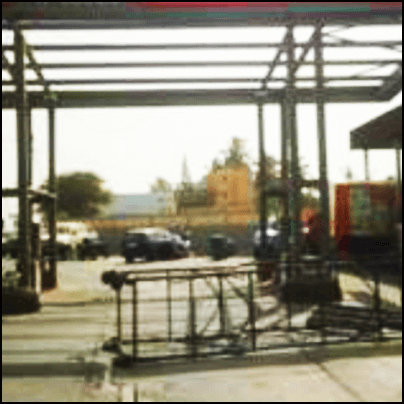-
What happened?
Two workers were carrying out a canopy cleaning operation at a service station, using a 4m/13ft high scaffold.
A worker on the ground attempted to change the position of the scaffold by pushing it.
The scaffold structure fell with the two workers on board.
One of the operators was injured, and received stitches to his head and hip.

-
Why did it happen?
The job was not carried out as planned:
- The use of scaffolding was not authorised by the contracting company.
- The work was meant to be completed using squeegees and sticks to avoid working at height.
The operators were not wearing safety harnesses.
The worker on the ground handled the scaffold in an unsafe manner.
The previous day, an inspector stopped work conducted by the same contractor on another site for unauthorised equipment use. Despite this, contractors continued to use the scaffold.
The scaffolding structure was not inspected before the job.
The poor safety culture of the contractor: contractor personnel not qualified and not aware of the risks.

-
What did they learn?
Raise awareness of good to practise standards and safety for all staff and contractors.
Verify all safety measures are in place. Make sure everyone is aware of the risks before starting work.
Rupture, tilting, falling off the platform, and dropped objects are some of the risks associated with scaffolding.
Serious or deadly accidents are mostly caused by inadequate use of scaffold, negligence and absence of inspection before starting work.
When working at height, adequate personal protective equipment (PPE) should be worn at all times.
Harnesses should be worn and always attached to a solid point or a lifeline.

-
Ask yourself or your crew
How can something like this happen here?
Do we need to use a scaffold for today’s job, or can find another, safer, way to work?
How would you intervene if you saw this happening on-site? Who would you report this to?
What else can we learn from this incident?

Add to homescreen
Content name
Select existing category:
Content name
New collection
Edit collection
What happened?
Two workers were carrying out a canopy cleaning operation at a service station, using a 4m/13ft high scaffold.
A worker on the ground attempted to change the position of the scaffold by pushing it.
The scaffold structure fell with the two workers on board.
One of the operators was injured, and received stitches to his head and hip.

Why did it happen?
The job was not carried out as planned:
- The use of scaffolding was not authorised by the contracting company.
- The work was meant to be completed using squeegees and sticks to avoid working at height.
The operators were not wearing safety harnesses.
The worker on the ground handled the scaffold in an unsafe manner.
The previous day, an inspector stopped work conducted by the same contractor on another site for unauthorised equipment use. Despite this, contractors continued to use the scaffold.
The scaffolding structure was not inspected before the job.
The poor safety culture of the contractor: contractor personnel not qualified and not aware of the risks.

What did they learn?
Raise awareness of good to practise standards and safety for all staff and contractors.
Verify all safety measures are in place. Make sure everyone is aware of the risks before starting work.
Rupture, tilting, falling off the platform, and dropped objects are some of the risks associated with scaffolding.
Serious or deadly accidents are mostly caused by inadequate use of scaffold, negligence and absence of inspection before starting work.
When working at height, adequate personal protective equipment (PPE) should be worn at all times.
Harnesses should be worn and always attached to a solid point or a lifeline.
Ask yourself or your crew
How can something like this happen here?
Do we need to use a scaffold for today’s job, or can find another, safer, way to work?
How would you intervene if you saw this happening on-site? Who would you report this to?
What else can we learn from this incident?
A scaffold was pushed over with two operators on board. The use of a scaffold was not authorised and no fall protection in place.













